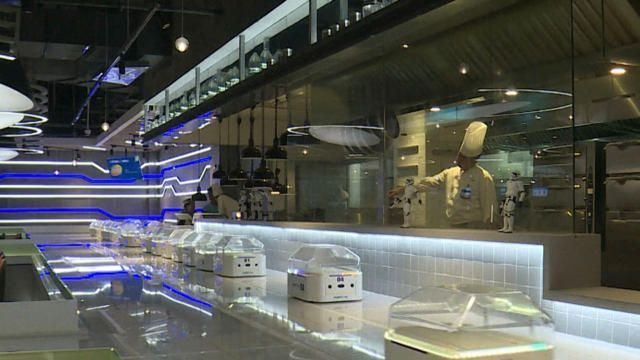Robots are making their way into many aspects of life in China.
Now, some are leaving the labs for shifts at restaurants.
CGTN’s Frances Kuo has more on how they’re changing the dining experience.
A quick glance across a restaurant in Shanghai, and you don’t notice anything unusual – until you realize that waiters are nowhere in sight.
That is, the kind of waiters one normally thinks of. Here, robots do the work.
“In a traditional restaurant, from queuing, to entering the restaurant, to seating and ordering, to the chef and serving food, it is all a series of steps to go through,” Cao Haitao, product manager of Hema Robot restaurant said. “With our digitized system, these steps can be performed in a closed circuit, for example customers can order food before they have been seated.”
And customers seem to like what the restaurant is dishing up.
“Selecting dishes and placing an order is all done through the app so it is quite convenient,” said Ma Yiwen, a customer. “The robots deliver the food, there are no traditional waiters serving, I think it’s quite original. So these advantages make it really convenient and high tech.”
“Food is served much faster here than other restaurants, and it is also very hygienic, the ingredients are fresh from the supermarket here,” said Ma Shenpeng, a customer. “That gives some assurance. And the price is very reasonable.”
The price is right for the restaurant as well; robots are cheaper than their human counterparts.
“Staff costs are getting higher and higher, and in Shanghai, a waiter can cost more than $1400 a month, “ said Cao.
By keeping staff costs down, the restaurant can pass along lower prices to consumers.
“The price is very reasonable,” Ma said.
The restaurant is an initiative of Chinese e-commerce giant, Alibaba.
Right next to the diner is a semi-automated supermarket.
Shoppers order on a mobile app. The items are then delivered via conveyor tracks on the ceiling and sent to checkout.
Alibaba now has 57 of these supermarkets in the country, all of which will eventually feature the robotic restaurants.
Experts believe China will see more automated services to help compensate for a shrinking labor force.
The government estimates that after 2020, the labor supply will drop by 100 million every 15 years.
But Beijing is trying to avoid job losses by bolstering its service sector instead of relying on manufacturing as China has in the past.
Though the cost of robots may still be too high for widespread consumer use, diners at the Hema Robot restaurant are happy to get a taste of their potential.
Chaohui Gong discusses robot technology and its impact on the labor force
CGTN’s Mike Walter talks with Chaohui Gong, founder and CEO of BITO Robotics Inc. about China’s robot technology and its impact on the labor force.
 CGTN America
CGTN America

